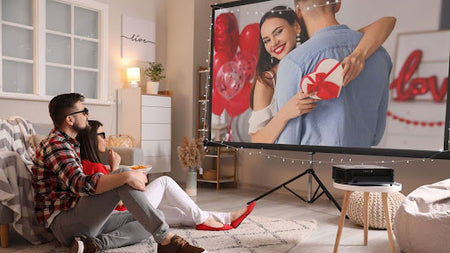Introduction
Building your own DIY home theater room can be as thrilling as challenging. Whether you're a cinephile seeking to replicate movie house experience or simply looking to amp up your entertainment area, the right setup can transform any ordinary room into a cinematic haven.
A top-notch projector like WeWatch lays a solid foundation for your home theater. Our projectors offer high-quality visuals crucial for an authentic movie theater feel. This guide will navigate the process, making the setup achievable in manageable steps.
What are the Basics of Home Theater?
Before you start building your home theater, there are a few basics you need to consider.
- Screen Size
When selecting the right screen size, consider your room's dimensions and the anticipated audience size. In a more intimate setting, such as a smaller room intended for family or a few friends, a moderately sized screen can provide an adequate and enjoyable viewing experience. Make sure to avoid choosing a screen that's too small. The goal is to enhance the viewing experience beyond what a standard television offers.
If you’re planning to accommodate larger groups, choose a larger screen. The key is to strike a balance: the screen should be large enough to offer an immersive experience without overwhelming the room's space.
- Projector

For home theaters, you want to prioritize image quality and the overall viewing experience. High resolution is key when choosing a projector.
You want a model with a superior ANSI rating to ensure brilliant image clarity and promises a more durable lifespan. Also, consider connectivity features. A projector that supports high-speed internet and is compatible with various media formats will offer greater flexibility and convenience.
The WeWatch V53PRO Projector emerges as a standout choice for home theater enthusiasts. Boasting native 1080p resolution with support for up to 4K, this projector is designed to deliver crisp, detailed visuals. Its integration of WiFi-6 and Bluetooth 5.0 technologies facilitates seamless streaming, enhancing your viewing experience.
- Sound System
Most film buffs agree that a movie is only as good as its sound. Consider installing a 7.1 sound system with speakers above the screen, on the left and right sides of the room and at the back.
- Seating Arrangements
The perfect seating arrangement in your home theater should combine practicality and personal preference. For larger spaces or groups, consider adopting a stadium-style seating layout. This tiered arrangement optimizes viewing angles for everyone and adds a touch of authentic theater ambiance.
On the other hand, if your home theater is primarily a family retreat, you want a cozier setup. Sofas and plush chairs create a more intimate and comfortable environment. Ultimately, the key is to align your seating arrangement with the room's dimensions and the number of people you want to accommodate.
How to Build a DIY Home Theater Room
Building a theater room can be easy and budget-friendly. The steps below will guide you through the process.
- Plan Layout
Before you start, plan a layout for your room and where you will attach it to your house. You want your design to be big enough for your needs. This includes screen size and the amount of seating you'd like to have. Make sure to consider the projector's throw distance when deciding the length of the room.
For added convenience, consider adding a small kitchenette with a sink, refrigerator, and microwave. That way, you'll always have snacks on hand. Also, decide whether you want to have windows or not. A room without windows will enhance picture quality but may not be practical if you decide to reuse the room for something else.
- Frame and Insulate
Once you have your layout, you can frame and insulate the space. Insulation is particularly important here, as good insulation can keep out unwanted sounds and prevent your theater from distracting the rest of the house.
- Pre-Wire Surround Sound
Pre-wiring surround sound in a home theater involves planning speaker locations and running cables before finishing walls. Strategically place wires for front, center, rear, and subwoofer speakers, ensuring they are concealed and protected. This foresight allows for easier installation of speakers and maintains the aesthetic of the room.
- Pre-Wire a Video Projector
Pre-wiring a video projector in a home theater involves running HDMI or AV cables from your media source to the projector's location, usually on the ceiling. It's important to ensure the cables are long enough and securely routed to avoid visible wires and trip hazards, while maintaining easy access for maintenance and upgrades.
- Pre-Wire Lighting
Pre-wiring lighting in a home theater requires planning for both ambient and accent lighting. Run electrical wiring to strategic locations for ceiling, wall sconces, or floor lighting, while considering the control system for dimming and automation. This setup enhances the cinematic experience and allows for mood adjustments according to the viewing content.
- Install Drywall and Sound Barriers
When installing drywall and sound barriers in a home theater, it's essential to use thicker drywall for better sound insulation. Consider adding a second layer of drywall with sound-damping glue for enhanced effectiveness.
Use resilient channels to decouple the drywall from the structure, reducing sound transmission. Incorporating insulation within the walls and ceiling also helps in soundproofing. Remember, sealing gaps and ensuring airtight construction is crucial in maintaining sound quality and preventing external noise intrusion.
- Set Up Video and Sound Systems
After pre-wiring for surround sound and the projector, as well as installing lighting and sound barriers, it's time to install and calibrate the equipment.
First, mount the projector in the pre-wired location. Make sure it’s properly aligned with the screen for optimal image quality. The projector should be at the right distance from the screen (throw ratio) to ensure the image fills the screen without distortion.
Next, install your surround sound speakers in their pre-planned positions. The front speakers should be at ear level when seated, while the rear speakers should be slightly higher to create an immersive sound field. The center speaker should be placed close to the screen. The subwoofer can be positioned at the front of the room for best bass distribution.
Calibration is crucial for both video and audio. Adjust the projector's settings for the best picture quality, taking into account room lighting and screen type. For sound, use a calibration tool to balance the audio output from each speaker.
This setup aims to create a harmonious balance between visual and auditory elements, making your home theater a true cinematic experience. Remember, patience and attention to detail during setup will pay off in the quality of your movie-watching sessions.
- Install Seating
Installing seating in a home theater requires careful consideration of space and viewer comfort. Measure your room to determine the maximum number of seats it can accommodate without feeling cramped.
Choose seats that complement your room's dimensions and viewing distance from the screen. You will want comfortable, cinema-style chairs with features like reclining backs and cup holders. Arrange the seats in a way that every spot offers a clear, unobstructed view of the screen.
DIY Home Theater Design Ideas
Transforming a space into a DIY home theater can be a fun and creative project. Here are some popular design ideas to inspire homeowners:
- Classic Cinema Style: Think red velvet curtains and plush, reclining seats for a traditional movie theater feel. Add vintage movie posters and a classic popcorn machine to complete the look.
- Modern Minimalist: For a sleek, contemporary vibe, opt for clean lines and a monochromatic color scheme. Incorporate built-in shelving for a neat media storage solution and minimalist furniture.
- Cozy and Comfortable: Create a warm, inviting space with comfortable sectional sofas and throw blankets. Soft lighting and acoustic panels can enhance the cozy ambiance.
- Family-Friendly Zone: If your theater room is also a family hangout, choose durable, easy-to-clean materials. Include a mix of seating options like bean bags for kids and comfortable chairs for adults.
- Tech-Savvy Retreat: For the ultimate viewing experience, invest in the latest technology. Think a high-definition projector, a state-of-the-art sound system, and smart lighting controlled by your phone.
- Themed Theater Rooms: Tailor your home theater to your interests – be it a sci-fi spaceship design, a sports-themed room, or a Hollywood glamour setup.
Remember, the key to a great DIY home theater is creating a space that reflects your personal style and meets your entertainment needs.
Conclusion
A DIY home theater is the perfect addition to a movie buff's home. You can experience your favorite films in an immersive, cinema-quality experience, all from the comfort of your home. By following these simple steps, you'll be watching movies in no time.



